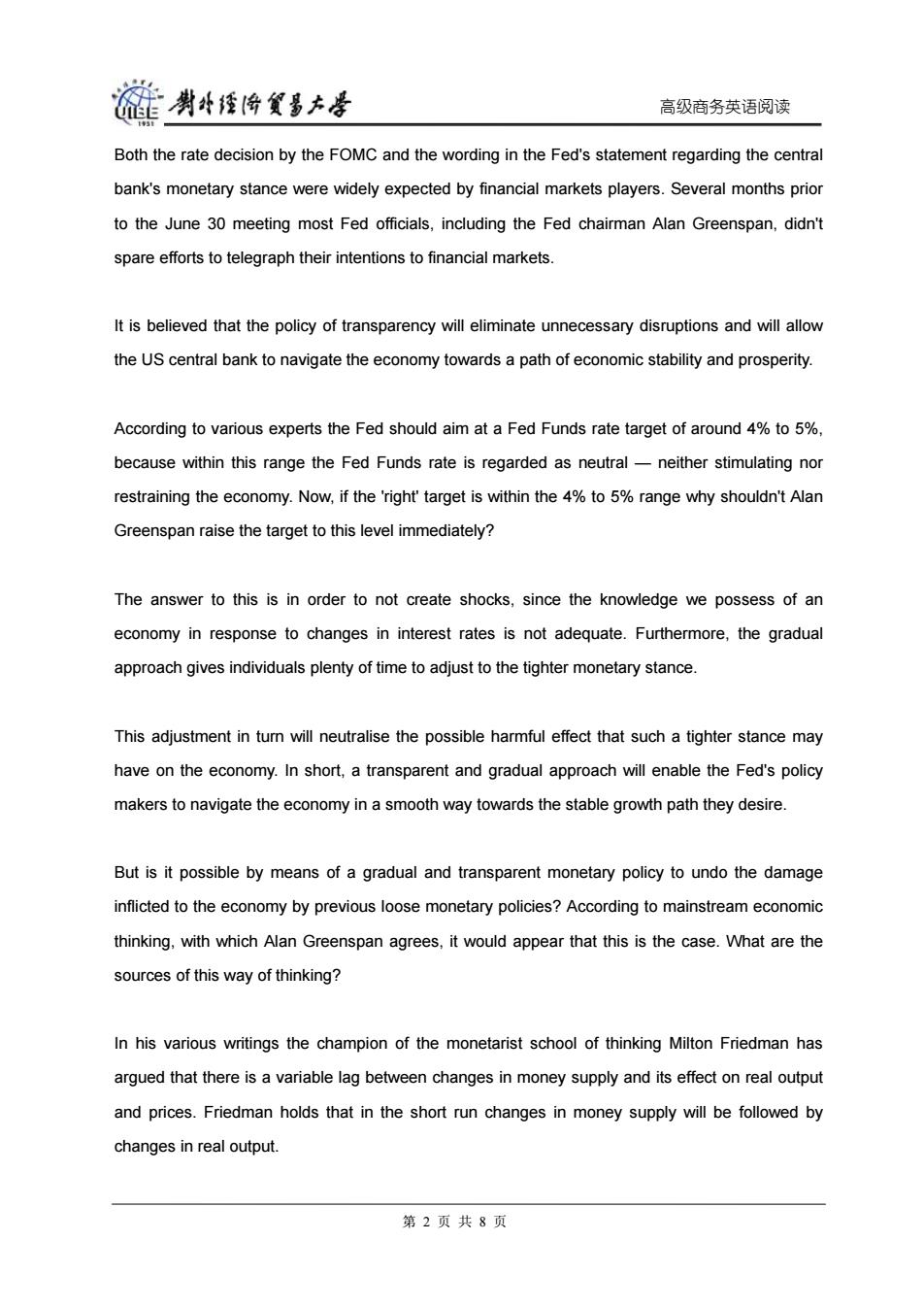正在加载图片...

链男母经降贸多大量 高级商务英语阅读 Both the rate decision by the FOMC and the wording in the Fed's statement regarding the central bank's monetary stance were widely expected by financial markets players.Several months prior to the June 30 meeting most Fed officials,including the Fed chairman Alan Greenspan,didn't spare efforts to telegraph their intentions to financial markets. It is believed that the policy of transparency will eliminate unnecessary disruptions and will allow the US central bank to navigate the economy towards a path of economic stability and prosperity. According to various experts the Fed should aim at a Fed Funds rate target of around 4%to 5%, because within this range the Fed Funds rate is regarded as neutral-neither stimulating nor restraining the economy.Now,if the 'right'target is within the 4%to 5%range why shouldn't Alan Greenspan raise the target to this level immediately? The answer to this is in order to not create shocks,since the knowledge we possess of an economy in response to changes in interest rates is not adequate.Furthermore,the gradual approach gives individuals plenty of time to adjust to the tighter monetary stance. This adjustment in turn will neutralise the possible harmful effect that such a tighter stance may have on the economy.In short,a transparent and gradual approach will enable the Fed's policy makers to navigate the economy in a smooth way towards the stable growth path they desire. But is it possible by means of a gradual and transparent monetary policy to undo the damage inflicted to the economy by previous loose monetary policies?According to mainstream economic thinking,with which Alan Greenspan agrees,it would appear that this is the case.What are the sources of this way of thinking? In his various writings the champion of the monetarist school of thinking Milton Friedman has argued that there is a variable lag between changes in money supply and its effect on real output and prices.Friedman holds that in the short run changes in money supply will be followed by changes in real output. 第2页共8页高级商务英语阅读 Both the rate decision by the FOMC and the wording in the Fed's statement regarding the central bank's monetary stance were widely expected by financial markets players. Several months prior to the June 30 meeting most Fed officials, including the Fed chairman Alan Greenspan, didn't spare efforts to telegraph their intentions to financial markets. It is believed that the policy of transparency will eliminate unnecessary disruptions and will allow the US central bank to navigate the economy towards a path of economic stability and prosperity. According to various experts the Fed should aim at a Fed Funds rate target of around 4% to 5%, because within this range the Fed Funds rate is regarded as neutral — neither stimulating nor restraining the economy. Now, if the 'right' target is within the 4% to 5% range why shouldn't Alan Greenspan raise the target to this level immediately? The answer to this is in order to not create shocks, since the knowledge we possess of an economy in response to changes in interest rates is not adequate. Furthermore, the gradual approach gives individuals plenty of time to adjust to the tighter monetary stance. This adjustment in turn will neutralise the possible harmful effect that such a tighter stance may have on the economy. In short, a transparent and gradual approach will enable the Fed's policy makers to navigate the economy in a smooth way towards the stable growth path they desire. But is it possible by means of a gradual and transparent monetary policy to undo the damage inflicted to the economy by previous loose monetary policies? According to mainstream economic thinking, with which Alan Greenspan agrees, it would appear that this is the case. What are the sources of this way of thinking? In his various writings the champion of the monetarist school of thinking Milton Friedman has argued that there is a variable lag between changes in money supply and its effect on real output and prices. Friedman holds that in the short run changes in money supply will be followed by changes in real output. 第 2 页 共 8 页